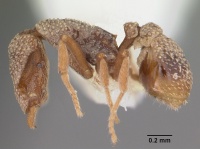Strumigenys agostii
| Strumigenys agostii | |
|---|---|

| |
| Scientific classification | |
| Kingdom: | Animalia |
| Phylum: | Arthropoda |
| Class: | Insecta |
| Order: | Hymenoptera |
| Family: | Formicidae |
| Subfamily: | Myrmicinae |
| Tribe: | Attini |
| Genus: | Strumigenys |
| Species: | S. agostii |
| Binomial name | |
| Strumigenys agostii (Bolton, 2000) | |
The type material was collected from humid forest leaf litter.
Identification
Bolton (2000) - A member of the Strumigenys disjuncta-group. S. agostii separates from the other two species of the group as follows.
S. agostii: Head very narrow, CI 58. Head in profile as deep at level of antennal insertion as at the level of the eye. Disc of postpetiole sculptured. Femora and tibiae with minute greyish appressed pubescence. Leading edge of scape with all hairs curved toward the apex of the scape. Dorsum of head in profile only with spoon-shaped hairs to occipital margin. No standing hairs at base of first gastral tergite. Basal tooth of mandible no shorter than fourth tooth from the base.
Strumigenys clotho and Strumigenys disjuncta: Head broader, CI 68-69. Head in profile shallower at level of antennal insertion than at the level of the eye. Disc of postpetiole smooth. Femora and tibiae with small appressed spatulate hairs. Leading edge of scape with one or more hairs curved toward the base of the scape. Dorsum of head in profile with larger and more elevated hairs near occipital margin. Standing hairs present at base of first gastral tergite. Basal tooth of mandible shorter than fourth tooth from the base. Apart from the above characters agostii also differs from clotho as the latter has no spongiform pad at the base of the first gastral sterite but has an apicoscrobal hair.
Keys including this Species
Distribution
Latitudinal Distribution Pattern
Latitudinal Range: -5.4° to -5.4°.
| North Temperate |
North Subtropical |
Tropical | South Subtropical |
South Temperate |
- Source: AntMaps
Distribution based on Regional Taxon Lists
Indo-Australian Region: Indonesia (type locality), New Guinea.
Distribution based on AntMaps
Distribution based on AntWeb specimens
Check data from AntWeb
Countries Occupied
| Number of countries occupied by this species based on AntWiki Regional Taxon Lists. In general, fewer countries occupied indicates a narrower range, while more countries indicates a more widespread species. |

|
Estimated Abundance
| Relative abundance based on number of AntMaps records per species (this species within the purple bar). Fewer records (to the left) indicates a less abundant/encountered species while more records (to the right) indicates more abundant/encountered species. |

|
Biology
Castes
Nomenclature
The following information is derived from Barry Bolton's Online Catalogue of the Ants of the World.
- agostii. Pyramica agostii Bolton, 2000: 412 (w.) INDONESIA (Aru I.). Combination in Strumigenys: Baroni Urbani & De Andrade, 2007: 115
Unless otherwise noted the text for the remainder of this section is reported from the publication that includes the original description.
Description
Worker
Holotype. TL 2.5, HL 0.69, HW 0.40, CI 58, ML 0.10, MI 14, SL 0.36, SI 90, PW 0.32, AL 0.74. Dorsal surfaces of head, alitrunk, waist segments and gaster densely clothed with pale spoon-shaped hairs that are subappressed to appressed; without standing hairs of any form on these surfaces. The hairs curve anteriorly on the head, toward the midline on the pronotum and posteriorly on the waist segments and gaster. With head in full-face view the dorsolateral margins with anteriorly curved spoon-shaped hairs similar to those on the dorsum; without apicoscrobal or other freely projecting hairs. Pronotal humerus without a projecting hair that is different from others on the dorsum. Spoon-shaped hairs on leading edge of scape sparse, all directed toward the apex of the scape (a couple of hairs on the right scape point forward but these have been disturbed during preparation of the unique specimen). Femora and tibiae with minute appressed greyish pubescence only, without spatulate hairs. Entirety of head and alitrunk, including propodeal declivity, densely reticulate-punctate; no smooth areas on side of alitrunk. Fourth tooth from base on mandible no taller than the basal. Scape narrow and subcylindrical in dorsal view, the subbasal angle extremely shallow, almost effaced. Head long and narrow in full-face view, CI 58; in profile head of almost equal depth throughout.
Pronotum in dorsal view without humeral angles, the sides and anterior margin of the pronotum forming a smooth narrow arch. Propodeum armed with a pair of minute triangular teeth that are subtended by narrow carinae. Petiole in profile without a ventral spongiform appendage but a minute carinate vestige remains beneath the node. Petiole node in profile with the anterior face higher than the dorsum is long. Ventral spongiform lobe of postpetiole large, the first gastral sternite with a well developed spongiform pad.
Type Material
Holotype worker, Indonesia: Aru Island, Wokam, 50 m., 22.viii.1991, #1 F911201, 5.40°S, 134.48°E, humid forest leaf litter (D. Agosti) (American Museum of Natural History).
References
- Baroni Urbani, C. & De Andrade, M.L. 2007. The ant tribe Dacetini: limits and constituent genera, with descriptions of new species. Annali del Museo Civico di Storia Naturale “G. Doria” 99:1-191.
- Bolton, B. 2000. The ant tribe Dacetini. Memoirs of the American Entomological Institute. 65:1-1028. (page 412, worker described)
References based on Global Ant Biodiversity Informatics
- Janda M., G. D. Alpert, M. L. Borowiec, E. P. Economo, P. Klimes, E. Sarnat, and S. O. Shattuck. 2011. Cheklist of ants described and recorded from New Guinea and associated islands. Available on http://www.newguineants.org/. Accessed on 24th Feb. 2011.

